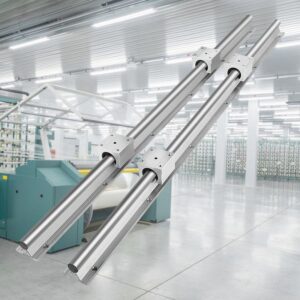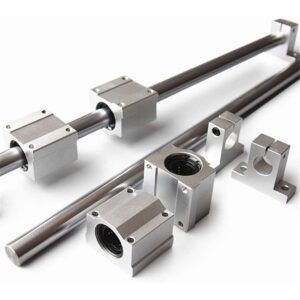Smooth, precise, and efficient motion is the backbone of every modern machine — from industrial robots to laboratory automation. The linear slide guide is the mechanical marvel that makes this possible. Acting as the bridge between motion and control, it allows parts to glide in a straight path with remarkable accuracy and minimal friction.
In this comprehensive guide, we’ll uncover how a linear slide guide works, its types, benefits, components, and what makes it indispensable in manufacturing and automation today.
Understanding Linear Slide Guide
A linear slide guide, also known as a linear motion guide, is a mechanical component that enables precise linear movement. It consists of a sliding block (or carriage) that moves along a fixed rail, supported by rolling or sliding elements.
The core principle behind a linear slide guide is to reduce friction between the moving and stationary parts, ensuring smooth, stable, and highly accurate motion. These guides are the foundation for equipment that requires repeatable, frictionless motion — such as CNC machines, robotic arms, and optical instruments.
Main Components of a Linear Slide Guide
Every linear slide guide is a finely engineered system consisting of several key parts:
Guide Rail: The stationary base track that defines the motion path.
Carriage (or Block): The movable element that slides along the rail.
Rolling Elements: Ball bearings or rollers that carry the load and minimize friction.
End Caps and Seals: Prevent contaminants from entering and retain lubrication.
Lubrication System: Ensures long life and smooth operation.
Mounting Holes: Allow easy installation onto machinery or equipment frames.
Each part works in harmony to ensure a precise, stable, and durable linear movement.
How a Linear Slide Guide Works
The working mechanism of a linear slide guide is based on rolling contact instead of sliding friction.
Inside the carriage, steel balls or cylindrical rollers roll along hardened raceways in the rail. As the carriage moves, these elements recirculate — exiting one end and returning through an internal loop to re-enter at the front.
This recirculating motion ensures continuous, friction-free operation. The result is a linear motion system that combines speed, rigidity, and accuracy unmatched by traditional slide mechanisms.
Types of Linear Slide Guides
Linear slide guides come in various designs to suit different industrial needs:
Ball Type Slide Guide: Uses recirculating steel balls for smooth motion and moderate load capacity.
Roller Type Slide Guide: Uses cylindrical rollers, ideal for high-load and high-rigidity applications.
Caged Ball Guide: Incorporates a ball retainer that minimizes noise, wear, and friction.
Miniature Slide Guide: Compact version for electronics, optical devices, and laboratory tools.
Wide Type Slide Guide: Offers enhanced stability and moment load resistance.
Each type balances trade-offs between precision, load, cost, and environmental resistance.
Advantages of Using Linear Slide Guides
Linear slide guides are essential in modern machinery due to their numerous advantages:
High Precision: Accurate motion with micrometer-level repeatability.
Low Friction: Rolling contact minimizes energy loss.
Durability: Hardened materials and advanced coatings ensure long service life.
Compact Design: Offers high load capacity in minimal space.
Rigidity and Stability: Supports loads in multiple directions.
Quiet and Smooth Operation: Especially in caged and preloaded models.
Reduced Maintenance: Self-lubricating options available.
These benefits make linear slide guides ideal for both heavy industrial and fine precision tasks.
Linear Slide Guide vs Linear Bearing
| Feature | Linear Slide Guide | Linear Bearing |
|---|---|---|
| Friction Level | Very low | Moderate |
| Motion Type | Rolling or recirculating | Sliding |
| Load Capacity | High (multi-directional) | Low to medium |
| Accuracy | Excellent | Moderate |
| Rigidity | Very high | Lower |
| Maintenance | Low | Moderate |
| Cost | Higher | Lower |
While linear bearings work well for light-duty applications, linear slide guides are superior for high-precision, heavy-load, and continuous operations.
Applications of Linear Slide Guides
Linear slide guides are used across multiple sectors where precision and reliability are critical:
CNC Machines: For cutting, milling, and drilling accuracy.
Industrial Robots: To ensure controlled and repeatable motion.
Medical Equipment: Imaging, surgery, and diagnostic devices.
Semiconductor Fabrication: Clean and accurate wafer handling.
Packaging and Printing Machines: Smooth, high-speed operations.
Optical Systems: Precise alignment in microscopes and lenses.
Their adaptability makes them the backbone of motion systems in almost every modern industry.
Materials and Surface Treatments
Choosing the right material impacts performance, corrosion resistance, and durability. Common materials include:
Carbon Steel: Affordable and strong, ideal for dry indoor environments.
Alloy Steel: Improved fatigue resistance for heavy-duty use.
Stainless Steel: Corrosion-resistant for humid or sterile environments.
Ceramic Balls: Lightweight, silent, and corrosion-free options for specialized setups.
Surface treatments like chromium plating, nitriding, or black oxide coating further enhance wear and corrosion resistance.
Key Performance Parameters
Understanding performance ratings ensures optimal selection and longevity:
Static Load Capacity: Maximum load without permanent deformation.
Dynamic Load Rating: Load capacity for continuous motion.
Moment Load Capacity: Resistance to torsional loads in roll, pitch, and yaw.
Rigidity: Ability to resist deflection under force.
Accuracy Grades: Defines the straightness and smoothness of motion.
Speed Rating: Maximum travel speed without compromising accuracy.
Each parameter helps match the guide’s capabilities to your machine’s requirements.
Preload and Rigidity in Linear Slide Guides
Preload is a small intentional force applied between the rail and rolling elements. It removes internal clearances, improving stiffness, accuracy, and vibration resistance.
However, over-preloading can cause excessive friction and heat generation. Thus, selecting the appropriate preload class — light, medium, or heavy — is essential based on the application’s load and motion precision.
Lubrication and Maintenance
Proper lubrication ensures long life and silent operation. Key tips include:
Use appropriate lubricant (lithium grease or light machine oil).
Clean before applying new lubricant.
Avoid over-lubrication, which attracts dirt.
Inspect seals regularly for wear or damage.
Follow manufacturer’s recommended intervals for re-lubrication.
Self-lubricating guides, equipped with grease reservoirs, reduce maintenance frequency significantly.
Installation Best Practices
A perfectly installed linear slide guide guarantees optimal performance:
Ensure rail flatness and alignment before mounting.
Use proper torque on bolts to avoid distortion.
Keep assembly areas clean to prevent contamination.
Check parallelism if using multiple rails.
Test motion manually before powering up.
Even minor misalignment can shorten the guide’s lifespan drastically.
Common Problems and Solutions
| Problem | Likely Cause | Solution |
|---|---|---|
| Rough Movement | Dirt or misalignment | Clean and realign rail |
| Noise or Vibration | Lack of lubrication | Apply recommended grease |
| Looseness | Wear or low preload | Replace or adjust block |
| Sticking Motion | Contaminants | Clean and reseal |
| Uneven Motion | Mounting surface uneven | Reinstall on a flat base |
Regular inspection and maintenance prevent these issues from escalating into costly repairs.
Environmental Protection and Durability
Linear slide guides often work in harsh industrial settings. Protecting them ensures long-term performance:
Seals and Scrapers: Keep out dust and debris.
Protective Covers: Shield against chips and coolants in machining environments.
Anti-Corrosion Coatings: For marine or humid conditions.
Temperature-Resistant Grease: For high-heat operations.
With proper protection, a linear slide guide can operate flawlessly for years.
Selecting the Right Linear Slide Guide
To choose the perfect guide for your project, consider:
Load type (static, dynamic, or moment)
Travel distance and required accuracy
Operating speed and duty cycle
Environmental conditions
Available space and mounting structure
Maintenance frequency and cost
Balancing these factors ensures you select a system that performs efficiently and lasts long.
Innovations in Linear Slide Guide Technology
Recent developments have pushed linear motion technology to new heights:
Ball Chain Systems: Reduce noise and collision between rolling elements.
Self-Lubricating Units: Eliminate the need for manual re-lubrication.
Smart Monitoring Sensors: Track vibration, temperature, and wear in real-time.
Lightweight Composites: Decrease inertia for faster response.
These innovations are transforming manufacturing and automation systems into more intelligent, efficient, and durable designs.
Future Trends in Linear Slide Guides
The future of linear slide guides lies in integration and intelligence. With the rise of Industry 4.0, future systems will:
Feature embedded sensors for predictive maintenance.
Use AI-driven motion optimization for smoother travel.
Offer lightweight carbon fiber or polymer rails for faster systems.
Enable remote diagnostics to prevent downtime.
As machines evolve, so too will the humble linear guide — becoming smarter, faster, and more reliable.
Linear Slide Guide
At its core, the linear slide guide represents the fusion of precision engineering and motion efficiency. It transforms rotational energy into perfect linear motion, allowing machines to perform complex, precise tasks with ease. Whether in industrial robotics or medical equipment, linear slide guides define the future of accuracy and dependability in motion systems.
Frequently Asked Questions
What is the main function of a linear slide guide?
It enables smooth, precise, and low-friction linear movement in machinery and automation systems.
How do I maintain a linear slide guide?
Keep it clean, well-lubricated, and aligned. Regular inspections and timely lubrication ensure longevity.
Can I use linear slide guides in high-speed applications?
Yes. With proper lubrication and preload, they handle high-speed motion with excellent stability.
Are linear slide guides suitable for vertical use?
Yes, but load direction, preload, and gravity effects must be considered during installation.
What’s the lifespan of a linear slide guide?
With proper maintenance, they can last for millions of operational cycles.
Can I use them in cleanrooms or laboratories?
Absolutely. Stainless steel and sealed models are perfect for contamination-free environments.
Conclusion
The linear slide guide remains one of the most crucial elements in mechanical motion systems. Its ability to deliver stable, precise, and efficient linear movement underpins countless industries. When properly selected, installed, and maintained, these guides ensure unparalleled reliability, reduce maintenance costs, and elevate the performance of modern automation.
From CNC tools to robotics and medical devices — the linear slide guide stands as a symbol of motion perfection and engineering excellence.
Inbound Link Suggestions
Link to: “How to Choose the Right Bearing for Your Machine”
Link to: “CNC Precision Motion Systems Explained”
Outbound Link Suggestions
Link to: “Guide to Lubrication Systems for Linear Motion”
Link to: “Understanding Preload in Motion Control Engineering”




